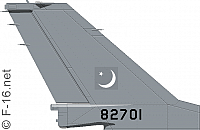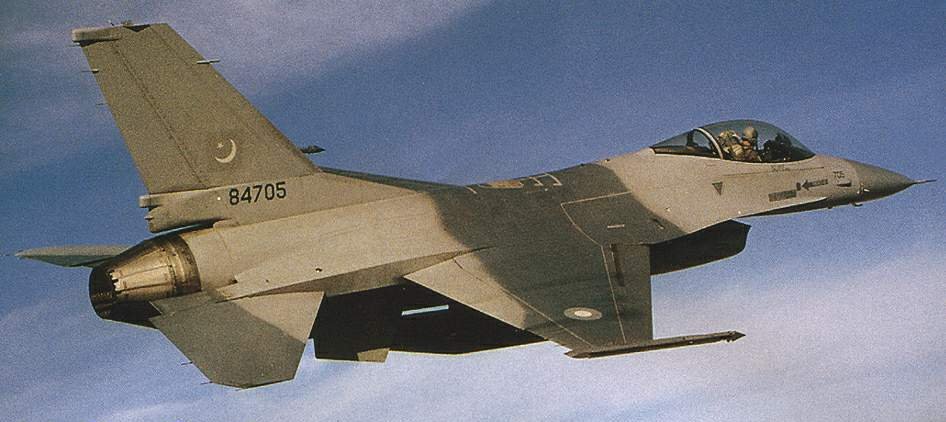Introduction
Pakistan has ordered a total of 111 F-16A/B aircraft. Of these, 71 were embargoed by the US due to Pakistan's nuclear weapons program. Of these 71, 28 were actually built but were flown directly to the AMARC at Davis-Monthan AFB for storage.
Over the years, various plans were conceived for these 28 aircraft: Pakistan wanted to get the aircraft or their money back; they were offered to various nations, none of which were interested; ultimately, the US Navy and USAF entered them into service as aggressor aircraft.
After Pakistan's help in the war on terror, the US lifted the embargo. In 2005, Pakistan requested 24 new Block 50/52 F-16C/Ds (with option for as much as 55 aircraft). Ultimately an order for 18 F-16s was placed with an option on another 18.
Inventory
Peace Gate I
In December 1981, the government of Pakistan signed a letter of agreement for the purchase of up to 40 F-16A/B (28 F-16A and 12 F-16B) fighters for the Pakistan Fiza'ya (Pakistan Air Force, or PAF). The deal would be split into two batches, one of 6 aircraft and the other of 34. The first aircraft were accepted at Fort Worth in October of 1982, and the first F-16, flown by Squadron Leader Shahid Javed, landed in Pakistan at Sargodha Air Base on January 15th, 1983 as part of a package of 6 'Peace Gate I' aircraft (2 A's and 4 B's).
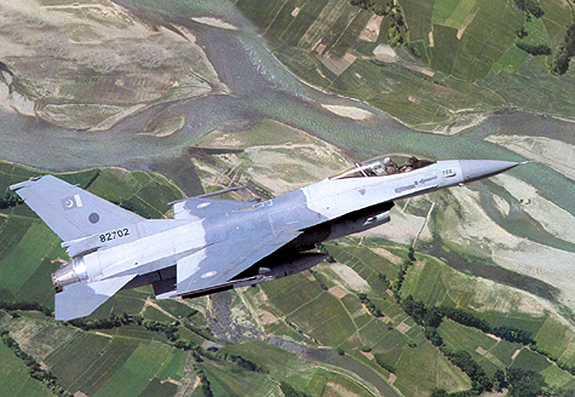
Peace Gate II
The remaining 34 aircraft were delivered under Peace Gate II. The Pakistani F-16A/B's are all Block 15 aircraft, the final version of the F-16A/B production run, and are powered by the Pratt & Whitney F100-PW-200 turbofan. All 40 'Peace Gate I & II' aircraft were delivered between 1983 and 1987. By 1997, 8 aircraft of the initial Peace Gate I & II order have been written off in various mishaps, hence 32 remain in service and despite the embargo, caused by the Pakistan-specific Pressler Amendment (see below), are being fully supported by commercial contracts.
The F-16s were assigned USAF serial numbers for record-keeping purposes, and carry a three-digit PAF serial number on their noses; the F-16A's being assigned numbers in sequence beginning with 701, and the F-16B's being assigned numbers beginning with 601. The two digit prefix preceding these numbers is the year of delivery of these aircraft. The PAF Falcons have a slightly altered color scheme, with the dark gray area covering most of the wings and the aft part of the horizontal tailplanes and carry toned-down markings: the national flag (normally a white moon and star on green field) on the tail and roundels on the upper wing surface.
Peace Gate III
Seven years after the first order, in December of 1988, Pakistan ordered 11 additional F-16A/B Block 15 OCU (Operational Capability Upgrade) aircraft (6 Alpha and 5 Bravo models) under the Peace Gate III program. These aircraft were purchased as attrition replacements and fully paid for, but are still awaiting delivery in the Arizona Desert. The reason for this is that Pakistan got involved in a controversy with the United States over its suspected nuclear weapons capability. Intelligence information reaching US authorities indicated that Pakistan was actively working on a nuclear bomb, had received a design for a bomb from China, had tested a nuclear trigger and was actively producing weapons-grade uranium. Furthermore, the F-16A's of no 9 and 11 squadrons at Sargodha AB have allegedly been modified to carry and deliver a Pakistani nuclear weapon. In addition, Pakistan has steadfastly refused to sign the Nuclear Non-Proliferation Treaty.
As a result, in accordance to the Pressler amendment to the Foreign Assistance Act, which forbids military aid to any nation possessing a nuclear explosive device, the United States government announced on October 6th, 1990 that it had embargoed further arms deliveries to Pakistan. The 11 Peace Gate III aircraft were consequently stored at AMARC (Aircraft Maintenance and Regeneration Center) at Davis-Monthan AFB, Arizona, also known as the Boneyard. There, they were put in 'Flyable Hold' for 5 years, during which time 85% of each aircraft's fuel system was preserved with JP-9, and each aircraft had its engine run once every 45 days. This resulted in the curious situation that most of those aircraft now have more engine run time than air time, the latter being only 6 hours. This low air-time figure, plus the fact that these aircraft are the most modern F-16A/B's built, is the main reason why countries interested in second-hand F-16s first look at the Pakistani airframes.
Peace Gate IV
In September of 1989, plans were announced by Pakistan to acquire 60 more F-16A/B's. A contract was signed in the same year under the Peace Gate IV Foreign Military Sales Programs, for the delivery of 60 F-16s for US $1.4 billion or approximately US $23 million a piece. By March of 1994, 11 of these planes had been built and were directly flown into the Sonoran desert where they joined the 11 Peace Gate III aircraft in storage. A further six aircraft were stored by the end of 1994, so that a total of 17 aircraft (7 F-16A's and 10 F-16B's) of the Peace Gate IV order are now stored. A stop-work order affected the remaining 43 planes of the Peace Gate IV contract.
The Brown amendment later eased the restrictions on weapon exports to Pakistan, but specifically excluded the F-16s from this release. Pakistan had already paid $685 million on the contract for the first 28 F-16s (11 Peace Gate III and 17 Peace Gate IV), and insisted on either having the planes it ordered delivered or getting its money back.
The saga of the embargoed F-16s
In March 1996, nine aircraft out of those which had already been manufactured for Pakistan, were sold to Indonesia. However, Indonesia cancelled this order on June 2nd, 1997. This 'unexpected' trouble with the Indonesian F-16 deal means a bigger problem to the Clinton administration both with respect to Pakistan and Indonesia. President Clinton had pledged to the Pakistan Prime Minister, Ms. Benazir Bhutto, that the money paid for the F-16s by Islamabad would be reimbursed if the equipment could not be delivered. In trying to come to terms with Islamabad's demand that Washington would return the money, the Clinton administration went on to see if the planes could be sold to a third country and the proceeds transferred. Interested buyers included amongst others the Republic of China.
At the end of 1997, with chances of finding a buyer close to zero, it was decided to take the PAF F-16s out of flyable hold and into the Boneyard. The airframes were offered to the Philippine Air Force, in view of its modernization plans. However, lack of funds precluded this deal as well.
In May 1998, a rumor suggested that the 28 Pakistani AF F-16A/B aircraft stored at the AMARC could possibly be donated to the Air Force of the Federation of Bosnia and Herzegovina, as a part of the US led 'Train & Equip' program. As Pakistan is already taking part in this program (training Bosnian Army Anti-tank missile teams), this is a solution that could satisfy both sides in this long dispute. Again, this proved to be not viable.
After the detonation of five nuclear devices by India in May 1998, in a remote area close to its border with Pakistan, Washington feared that this might escalate the old border dispute between Pakistan and India to a full crisis. In order to keep Pakistan from responding to this challenge, US president Bill Clinton suggested that the 28 stored F-16s would be delivered after all, in batches of 1 or 2. However, the internal pressure on the government proved to strong and shortly after India's demonstration, Pakistan responded by detonating an unknown number of nuclear devices.
Finally, on December 1st, 1998, the New Zealand Government announced that it would lease-buy the 28 Pakistani F-16s stored at the AMARC. Three days later, the United States said they hoped for an 'early and fair' agreement on how to compensate Islamabad for its aborted purchase of US F-16 fighters. President Clinton briefed Pakistani Prime Minister Nawaz Sharif on US efforts to compensate Pakistan for the $658 million it paid for the 28 F-16s. US officials said the United States has already paid $157 million of this back to Islamabad, raising the money by selling aircraft components to other countries. New Zealand agreed to pay some $105 million over 10 years to lease the fighters, providing additional funds that could be used to give Pakistan some of its money back.
At the end of 1998, the United States announced it would pay Pakistan $326.9 million in cash and up to $140 million in other compensation to settle the eight-year dispute. The $140 million will include about $60 million in US white wheat that Pakistan will receive during the current US fiscal year, which began on October 1st. The remaining $80 million in compensation will be negotiated by the two sides. The F-16 issue has been a headache for Pakistan, which is grappling to repay millions of dollars on its $32 billion in foreign debt amid a hard currency drought caused by sanctions and the suspension of International Monetary Fund programs.
In 1999 a new New Zealand government was elected who started a major reorganisation of the armed forces. One major element in this was the cancellation of the F-16 contract and the disbandment of its fighter force. The planes stayed in the boneyard for just a little longer.
In 2002, the US finally stopped trying to sell the aircraft and decided to assign them to the USAF and US Navy to fill the Aggressor role. After the demise of the (T)F-16N aggressor force, the US Navy lacked a high-performance aggressor aircraft. Because of the low airframe life of the embargoed Pakistani F-16s, these airframes were ideally suited for the demanding aggressor role. The 28 aircraft were thus evenly split between the USAF and the US Navy, and will take a vital role in DACT training of US forces.
After the attacks on 9/11 the Pakistani government became a major US ally in the war on terror. It was decided to redeliver those aircraft to Pakistan. Untill now, only half of them has been redelivered, with the remainder still to follow.
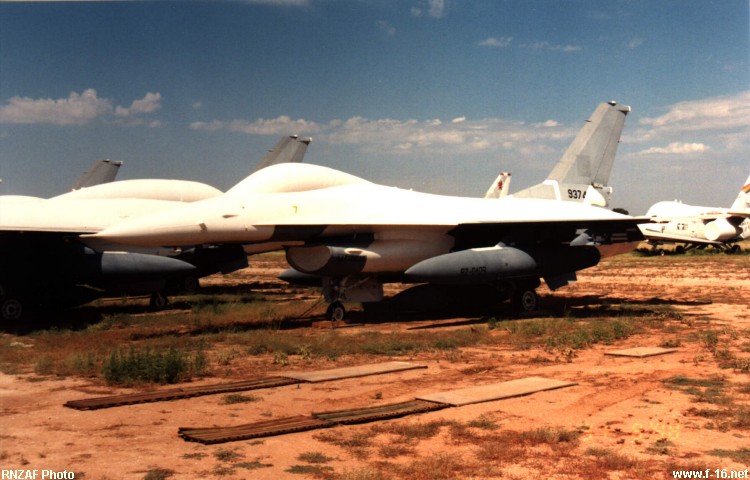
Peace Drive
On March 25th, 2005, the US Government announced that it had agreed to Pakistan's request to sell new F-16s. Initially, Pakistan has requested an additional 24 new Block 50/52 F-16C/Ds (with option for as much as 55 aircraft). Not much details are known at this moment about a possible sale of the aircraft to Pakistan. The deal is expected to be concluded by September or October of 2005. As part of the package, it was also agreed that the current fleet of older A/B models would get the MLU update.
As a sign of good gesture, the US agreed to supply Pakistan with a number of F-16s who where build under the Peace Gate III/IV programs.
Finally, after long series of negotiations, on September 30th, 2006 the contract was signed between the Pakistani and US government for the acquisition of 18 new F-16C/D block 52 aircraft and an option for another 18 more. In the deal the re-delivery of the 26 remaining Peace Gate III/IV aircraft was also agreed and the upgrade of those aircraft - and the remaining F-16A/B fleet - to MLU standards.
This order was granted and given a new FMS name at Pakistan's request. Albeit it already had the Peace Gate program, the PAF decided to choose another name since Peace Gate had too much negative commotion since the embargo of the last batch of aircraft.
Second hand purchase
In late 2013 it became apparent that Pakistan was to acquire a batch of second-hand Jordanian F-16s. Program details have these to be 12 A-models and 1 B-model. Supposedly they are 'standard' models without the MLU upgrade. Although this seems to be unlikely since Jordan doesn't have that quantity of non-MLU F-16s in their inventory any longer and it would also seems strange since Pakistan is updating its older airframes with the MLU upgrade package, adding another non-standard airframe to the inventory. Time will tell which airframes are included in this deal and in which form (MLU or non-MLU) they are delivered.
When deliveries started in May of 2014 is was obvious that the order compromised the Jordanian airframes of the Peace Falcon I order. Three of those crashed over the years with 13 of them remaining. Although only one B-models was announced with the first delivery already 2 were on the tarmac and the other 2 followed soon. So now it is obvious that the order compromised 9 A-models and 4 B-models in the ADF version. These airframes haven't been upgraded to MLU standard. With Pakistan upgrading all its older A/B models to the MLU standard it would seem obvious that these airframes will also be upgraded accordingly. The future will tell us whether this will come to fruition.
| Program | Model | Block | Qty. | Serials | Delivered |
|---|---|---|---|---|---|
| Peace Gate I | F-16A | Block 15 | 2 | 82701/82702 | 1983 |
| F-16B | Block 15 | 4 | 82601/82604 | 1983 | |
| Peace Gate II | F-16A | Block 15 | 26 | 83703, 84704/84719, 85720/85728 |
1983-1987 |
| F-16B | Block 15 | 8 | 82605, 84606/84608, 85609/85612 |
1983-1987 | |
| Peace Gate III | F-16A | block 15OCU | 6 | 91729, 92730/92734 | embargoed |
| F-16B | Block 15OCU | 5 | 91613, 92614/92617 | embargoed | |
| Peace Gate IV | F-16A | Block 15OCU | 7 | 92735/92739, 93740/93741 | embargoed |
| F-16B | Block 15OCU | 10 | 92618, 93619/93621, 94622/94624, 95625/95627 |
embargoed | |
| F-16A | Block 15OCU | 41 | 9_742/9_782 | stop-work | |
| F-16B | Block 15OCU | 2 | 9_628/9_629 | stop-work | /|
| Peace Drive | F-16C | Block 52 | 12 | 10901/10912 | 2010 |
| F-16D | Block 52 | 6 | 10801/10806 | 2010 | |
| Second hand | F-16A | Block 15ADF | 9 | 14732/14740 | 2014 |
| F-16B | Block 15ADF | 4 | 14624/14627 | 2014 |
Modifications & Armament
Modifications
The Pakistan Air Force currently has the Block 15 F-16A/B model in operation, which has an upgraded APG-66 radar that brings it close to the MLU (Mid-life Update) radar technology. The main advantage is the ability to use the AIM-7 Sparrow and AIM-120 AMRAAM missiles if they were ever to be released to the PAF. Furthermore, the radar is capable of sorting out tight formations of aircraft and has a 15%-20% range increase over previous models. All the earlier F-16s were brought up to OCU standards and have received the Falcon UP structural modification package.
In 2010 it was announced that Pakistan would order MLU kits to upgrade all its older A/B models to bring them up to the same standard with this upgrade package and to have some similarities with their new block 52 airframes.
Armament
Currently, Pakistani F-16s typically carry two all-aspect AIM-9L Sidewinders on the wing tip rails along with a pair of AIM-9P-4's on the outermost underwing racks, while the Matra Magic 2 (French counterpart of the Sidewinder) can be carried as well. They also have an important strike role, being capable to deliver Paveway laser-guided bombs. Pakistani F-16s are also capable of firing the French AS-30 laser guided missile. The ALQ-131 pod is carried as ECM protection.
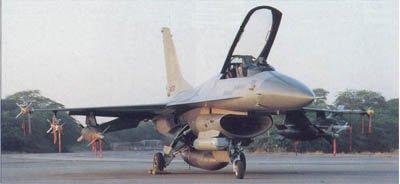
Atlis laser designation pod
Pakistan has acquired the French-built Thompson-CSF ATLIS laser designation pod for use on its F-16s. The ATLIS pod was first fitted to Pakistani F-16s in January 1986, thus making the F-16 the first non-European aircraft to be qualified for this pod.
Operational Service
Units
Please refer to the F-16 Units section for an overview of units.Deployments
|
Combat Pakistan was the second nation (after Israel) to use the F-16 in combat. The Soviet invasion of Afghanistan in 1979 in support of the pro-Soviet government in Kabul, which was being hard-pressed by Mujahadeen rebel forces, marked the start of a decade-long occupation. Mujahadeen rebels continued to harass the occupying Soviet military force as well as the forces of the Afghan regime that it was supporting. The war soon spilled over into neighboring Pakistan, with a horde of refugees fleeing to camps across the border in an attempt to escape the conflict. In addition, many of the rebels used Pakistan as a sanctuary from which to carry out forays into Afghanistan, and a steady flow of US-supplied arms were carried into Afghanistan from staging areas in Pakistan near the border. This inevitably resulted in border violations by Soviet and Afghan aircraft attempting to interdict these operations. Between May 1986 and November of 1988, PAF F-16s have shot down at least eight intruders from Afghanistan. The first three of these (one Su-22, one probable Su-22, and one An-26) were shot down by two pilots from No. 9 Squadron. Pilots of No. 14 Squadron destroyed the remaining five intruders (two Su-22s, two MiG-23s, and one Su-25). Most of these kills were by the AIM-9 Sidewinder, but at least one (a Su-22) was destroyed by cannon fire. Flight Lieutenant Khalid Mamood is credited with three of these kills. At least one F-16 was lost in these battles, this one in an encounter between two F-16s and six Afghan Air Force aircraft on April 29th, 1987. However, the lost F-16 appears to have been an 'own goal', having been hit by a Sidewinder fired by the other F-16. The unfortunate F-16 pilot (Flight Lieutenant Shahid Sikandar Khan) ejected safely. |
Special thanks
- R.M.S. Azam Viper;
Please use this form to add any list any error or omissions you find in the above text.
Note: your comments will be displayed immediately on this page. If you wish to send a private comment to the webmasters, please use the Contact Us link.

